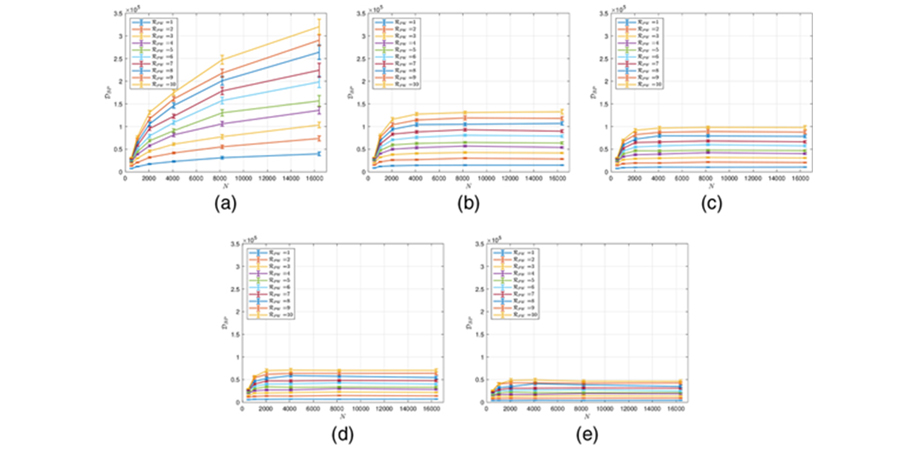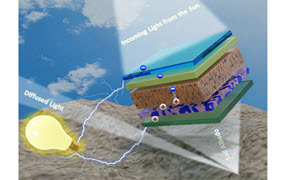Shedding light on turbulence with wave-optics simulations

Have you ever wondered why stars appear to “twinkle” in the night sky? These fast and seemingly random changes in the color and brightness of stars arise from how light interacts with different layers of the Earth’s atmosphere. During turbulence, different volumes of air can move very differently relative to each other. As a result, a pair of light beams traveling along even slightly different paths through turbulence are affected very differently.
Due to its relevance in many optics-related fields, such as astronomy and laser-based communications, the phenomenon of twinkling, or “scintillation,” cannot be ignored. In particular, when light beams propagate through a deeply turbulent medium, strong scintillation effects cause them to interfere constructively and destructively with each other at certain points in the pupil of the receiver. These so-called “branch points,” prominent distortions in the measured phase of the received light, are considered the Achilles’ heel of Adaptive Optics (AO) systems. In AO, carefully designed deformable mirrors are used to preemptively cancel out the expected distortion in incoming light. Unfortunately, practical mirrors cannot compensate correctly for the abrupt jumps in phase that occur at and near branch points.
One approach to overcome the problems caused by branch points is to study their effects in detail through wave-optics simulations. However, the branch-point problem is multifaceted in nature, and many parameters need to be considered simultaneously to produce reliable and realistic results. This was one of the main goals of a recent study published in Optical Engineering. The study was conducted by a team of scientists led by Dr. Jeffrey R. Beck of Michigan Technological University, USA.
Specifically, the team investigated how the number of observable branch points in a wave-optics simulation changes with grid sampling, i.e., the resolution of the simulation. In addition, they sought to shed light on the effects of a non-zero inner scale of turbulence on the simulation results. Put simply, the “inner scale” refers to the minimum size below which the eddies (swirling fluids and the reverse current generated in a turbulent flow) in a turbulent medium begin to dissipate from friction caused by collisions between fluid molecules.

Single realization of Kolmogorov turbulence, where RPW=1.0. The asterisks denote the location of the positive branch points, and the circles denote the location of the negative branch points. Credit: Beck et al., doi 10.1117/1.OE.61.4.044104
The team conducted hundreds of wave propagation simulations under a wide variety of turbulence conditions and observed how the number and distribution of branch points varied with each parameter. Contrary to what was expected, they found that the density of branch points did not grow indefinitely as the grid resolution increases. While it was previously believed that the branch-point density grows without bound with increasing resolution, this did not seem to be the case as per this study.
“Our results show that without considering the effects of a non-zero inner scale, the branch point density indeed grows without bound. However, as the size of the inner scale increases, this unbounded growth decreases under stronger turbulence conditions and ultimately tapers off — or ‘saturates’ — for sufficiently high grid resolutions,” said Beck. This remarkable finding could pave the way towards more accurate modeling of the energy distribution in a turbulent volume with wave-optics simulations.
Overall, this study provides important insights on the complex problem of branch points in AO systems and could help researchers improve their wave-optics simulations and models. “The results shown in our paper are encouraging from the standpoint that they could readily improve the performance of existing branch-point-tolerant phase reconstruction algorithms used in AO, as well as pave the way to future developments,” said Beck.
Finding effective ways to tame branch points will mitigate the effects of turbulence in astronomy and laser-based communications. This, in turn, can allow scientists to perform and interpret experimental results better without the pesky scintillation artifacts.
Read the Gold Open Access article by Beck et al., “Wave-optics investigation of branch-point density,” Opt. Eng., 61(4), 044104 (2022), doi 10.1117/1.OE.61.4.044104.
| Enjoy this article? Get similar news in your inbox |
|



